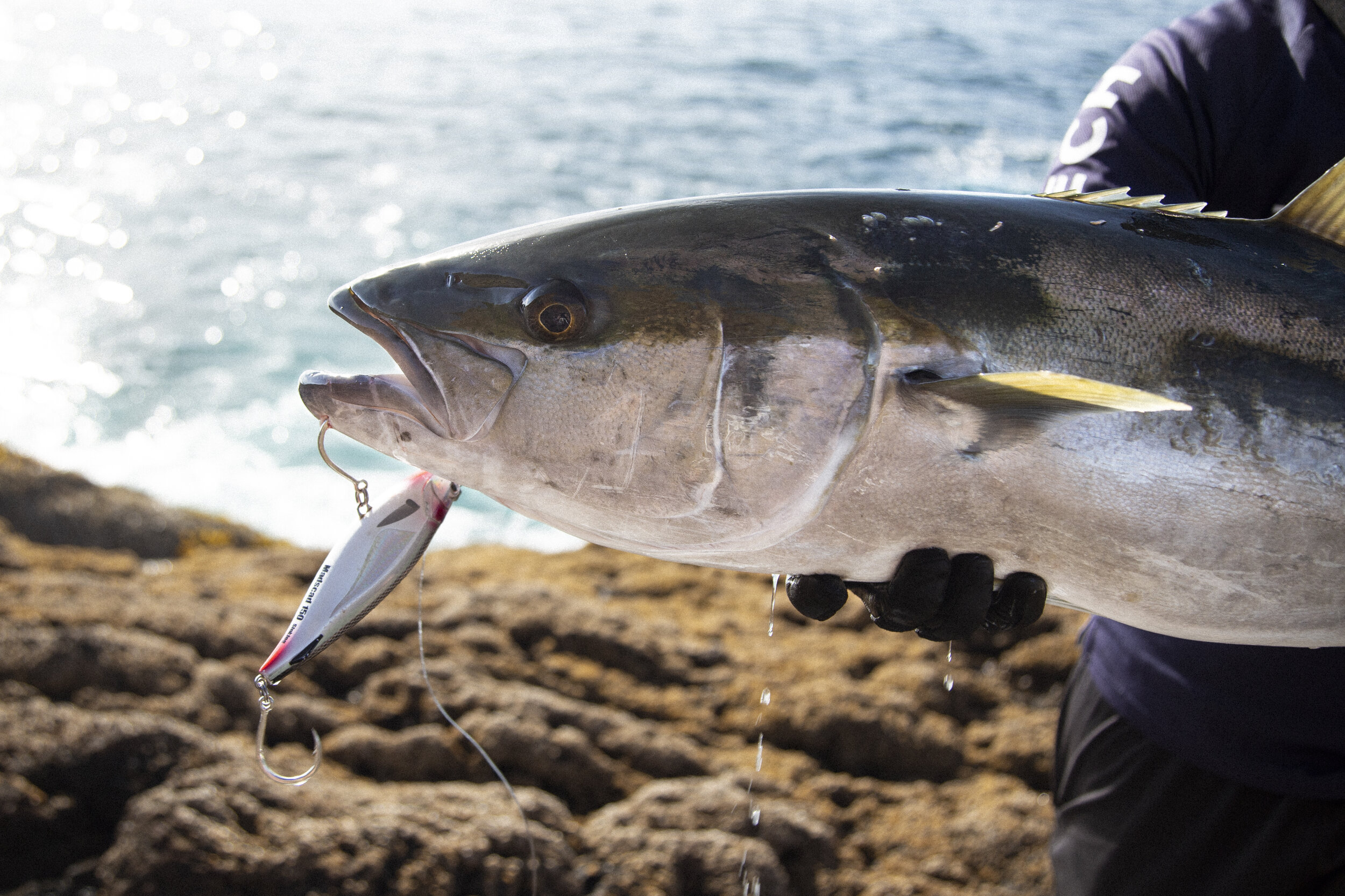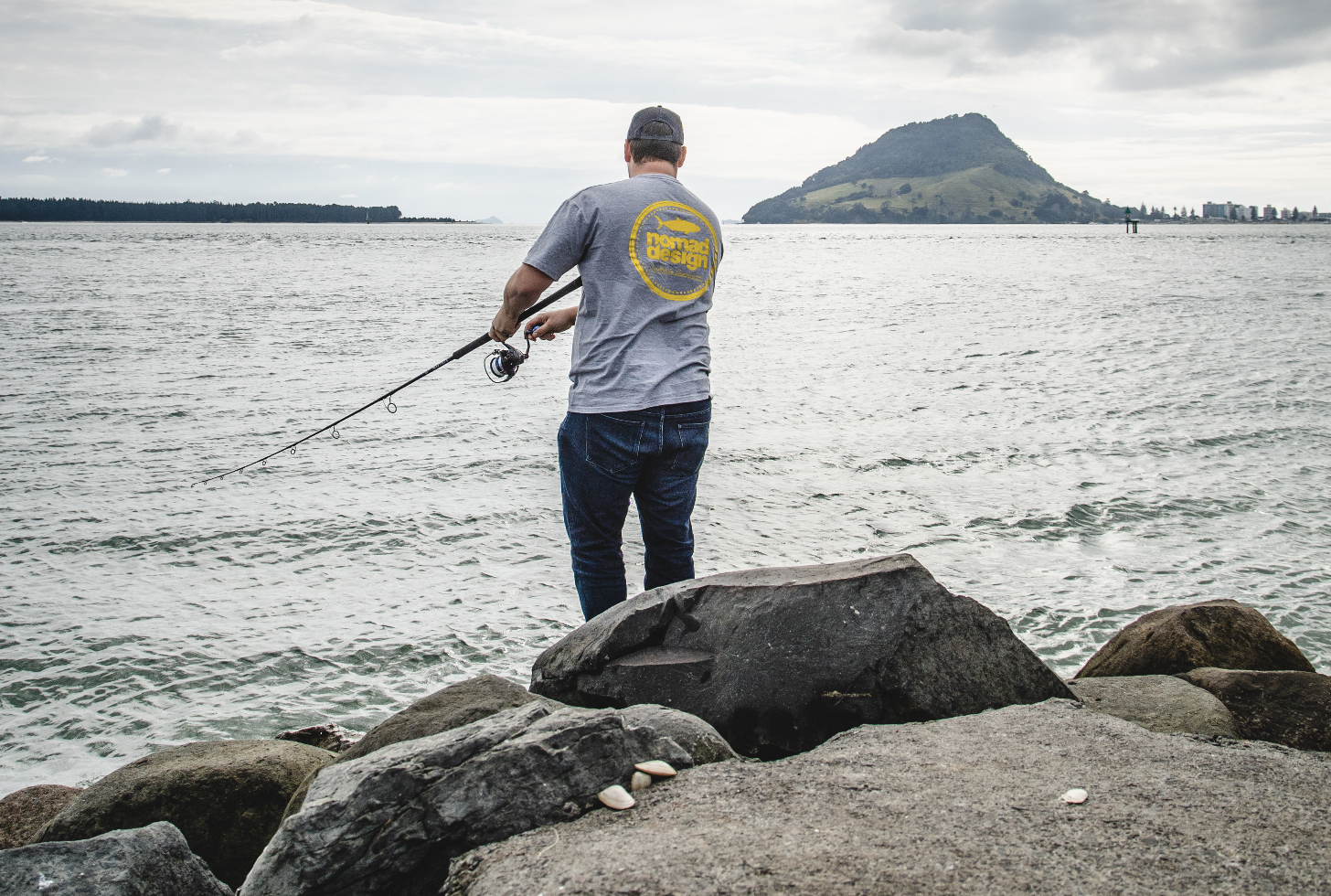Image: Finn Innes - @finn_spins
Land-based Top-Water Fishing
It’s always a great time when you get outside and explore the local shorelines, try something new, and hopefully come away with a fish to show for it. The following advice is based around targeting Kingfish from the shore in Tauranga Harbour, but many of these techniques will be applicable to other sheltered harbours throughout New Zealand. This is by no means a fully comprehensive guide to land-based fishing - we’re not going into detail about equipment, but if you’re getting started or want to try something new, you may find some useful information here.
To get the most out of fishing from the land, it’s important to note a few things about how Kingfish behave.
Tip #1: Kingfish like structure This applies to both inner-harbour and out deep. For example, if there’s a reef, steep-incline, rock, or channel marker breaking up the flow of the current, there’s an increased chance of finding some fishy action. The same applies to foul ground and kelp forests. Anywhere the Kingfish can hide from the current, or easily stalk prey has the potential to produce. Keep in mind that this isn’t a solid rule (especially inside the harbour where you’ll often find smaller specimens in the tidal flats feeding on baitfish), but it’s a good place to start when looking for potential spots.
Tip #2: Along with structure, you’ll want a bit of current, such as change of tide. From experience, the incoming tide seems to produce more action, but this entirely depends on location, and there’s no reason not to fish both the incoming and outgoing tide to see what works better in your area. A bit of current means its more likely that your target fish is sheltering behind structure, then popping out and feeding on the bait-fish as they’re being flushed past.
With these points in mind, here’s a few locations that we would recommend:
GENERAL Harbour
Fortunately for us in New Zealand, an appropriate harbour is within local proximity to most people. The warmer seasons are when Kingfish are most abundant in the harbours and shorelines, but it’s not unheard of to catch a harbour kingfish in the off season. As mentioned above, a general rule of thumb is that Kingfish will typically shelter and hide around structure - meaning wharves, channel markers, and rocks could all be potential spots to cast around - if you can get close enough. Aim to be out casting at the change of tide. This can of course change depending on your location. With no access to rocks or boats during level three, it may be harder to fish the channel markers, but get out there and do some exploring, you may find a new spot that you never knew about.
‘Popper Point’ is one of the most well known spots in Tauranga Harbour, providing both an easy location and regular hook ups.
Harbour Channels
A good technique is walking out and fishing harbour channels at low tide. These spots are known to produce Kingfish, Snapper, and Kahawai etc as they get flushed past in narrow sections with the tide. This is also a great way to get close enough to send a few casts towards channel markers. If you’re able to throw your lure from a position on the shore, perfect. Otherwise, walking out onto the exposed flats will get you closer to the edge of the channel. Don’t be afraid to get your legs wet with this one, as the closer to the channel your casts are, the more likely you are to attract some attention from a nearby fish. To maximise your chances of catching something here, use a small-medium size bait. A lure like the Riptide 155mm, or 140mm is our go-to size for these locations, which allows the occasional by-catch of Snapper or Kahawai.
Note: Please be wary of how the tides in your area change and flood the flats - unless you’re confident in your knowledge of the tides and local area, it’s probably best to leave this one for an outgoing tide only and try stick as close to the shore as possible.
Casting as close to channel markers as possible is a sure fire way to get in the zone for a hungry King.
Harbour Flats
If the geography of your local harbour allows it, fishing from the shore and casting into the shallow tidal flats can produce fish. Smaller Kingfish will hang around in the shallows close to shore as they pluck baitfish from around fallen trees and other shallow water structure. We’ve caught kingfish that were hanging out in less than 1m of water and less than 10m from the shore, which always makes for a fun and highly visual fight. The fish you catch in these locations may not be the biggest around, but when you’re limited on where you can go, spending an afternoon targeting these guys is definitely better than nothing. Keep a close eye out for large swirls and splashes on the surface, as this is a big indication that Kingfish could be feeding in these locations.
The Riptide 155mm is perfectly sized for the small-medium sized kingfish that are commonly found in the harbour.
Beach Stick-baiting
An uncommon technique is casting a stick-bait into the surf. We’d consider this one more of a fun challenge than anything else, but we’ve seen a few Snapper and Kahawai landed using this method. Kingfish are possible, but much less common. We’d recommend the 115mm Madscad for this one because it easily sinks below the surf - meaning maintaining a proper swimming action is much easier. Try not to bargain too much on catching anything here, it’s not the best way to fish the beach. But if you’re looking to get out of your comfort zone and try a new challenge, this option is easily accessible and highly rewarding when it results in a catch.
Image: Grant Foster - @addiction_unleashed
Lures
As far as lures go, we recommend carrying a selection of styles so you can adapt to the location, time of day, target species, and season. At a minimum, a mid-sized stickbait is essential; bigger isn’t always better for in-shore casting and you may find the heavier setups lack the finesse required to hit the mark in water that’s scattered with potential snags. A couple of suggestions would be the 155mm Riptide, 115mm Madscad, or the 105mm Riptide. Carrying both a floating style and sinking style lure will also help when conditions call for one or the other. Additionally, it would be a good idea to also carry a popper style lure, such as the 120mm Chug Norris, which works wonders at getting dormant Kingfish a little bit more excited to give chase.
A small selection of colours will also give you the chance to change things up if there’s fish around but you can’t seem to entice a bite. It’s impossible to say what colours work best, as they will all catch fish, but we generally recommend starting off with the more natural colours because they mimic a Kingfish’s natural prey baitfish. In saying that, there’s been plenty of times where a bright tropical colour like the Purple Fusilier will get the first take.
Remember to be sensible, be safe and don’t take any unnecessary risks. Land-based fishing isn’t without risk. We always recommend crushing the barbs on your hooks, but even more-so when you’re casting off a crowded wharf. Try to stick to flat ground and man-made jetties and wharves in your local area, and use this opportunity to get out and have some fun outdoors.







